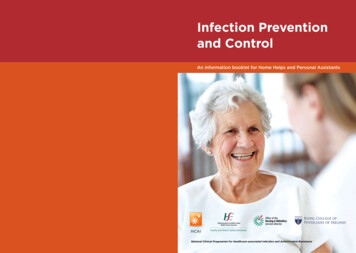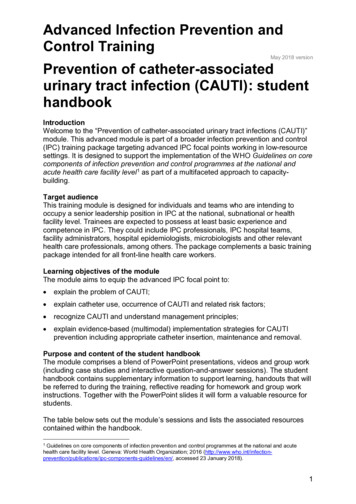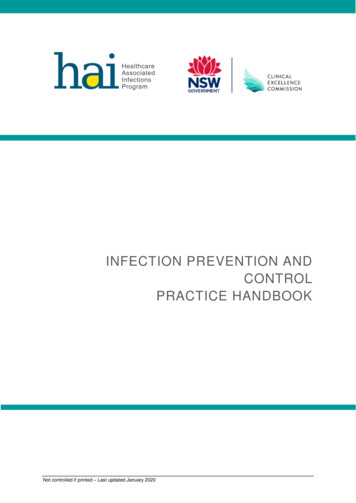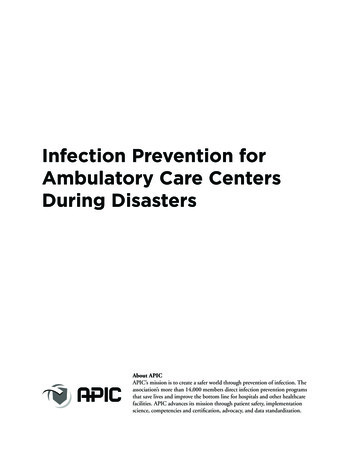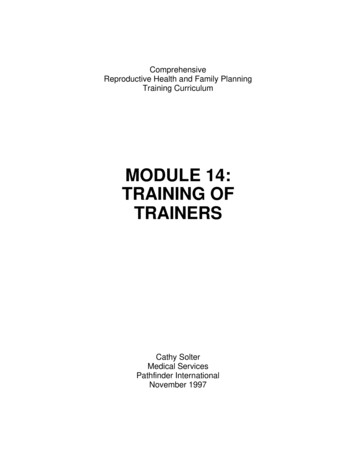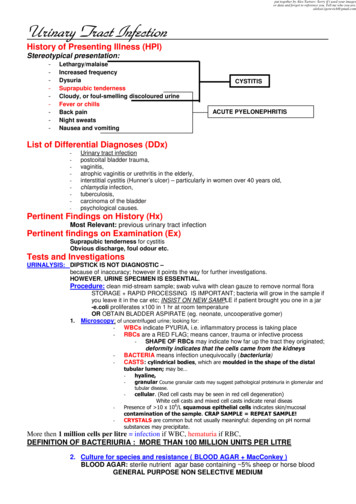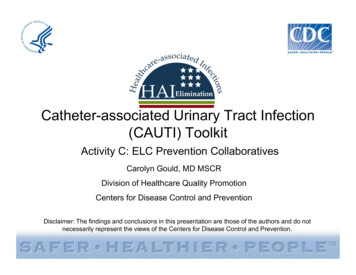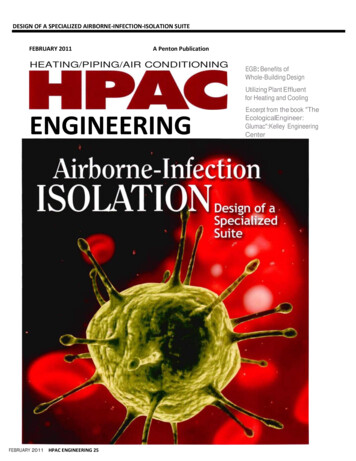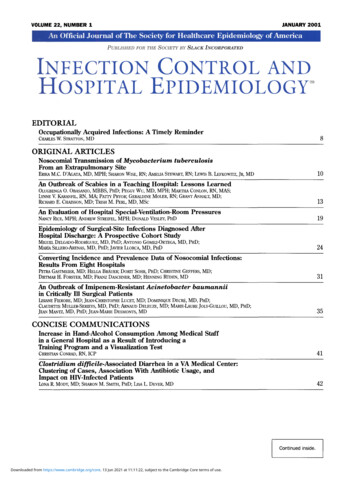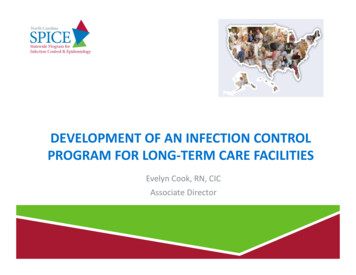
Transcription
ComprehensiveReproductive Health and Family PlanningTraining CurriculumMODULE 2:INFECTIONPREVENTIONCathy SolterMedical ServicesPathfinder InternationalSeptember 1997
1997 Pathfinder International. Any part of this document may be reproduced oradapted to meet local needs without prior permission from Pathfinder Internationalprovided Pathfinder International is acknowledged, and the material is madeavailable free of charge or at cost. Please send a copy of all adaptations from thismanual to:Medical Services DivisionPathfinder International9 Galen Street, Suite 217Watertown, MA 02172-4501Funds for this Comprehensive Reproductive Health and Family Planning TrainingCurriculum were provided in part by the Agency for International Development(USAID). The views expressed are those of Pathfinder International and do notnecessarily reflect those of USAID.Pathfinder InternationalPrevention CurriculumiInfection
ACKNOWLEDGEMENTSThe development of the Comprehensive Family Planning andReproductive Health Training Curriculum, including this module,is an ongoing process and the result of collaboration betweenmany individuals and organizations. The development process ofthis curriculum began with the privately-funded ReproductiveHealth Program (RHP) in Viet Nam. This manual is based on theadaptation of the Family Planning Course Modules, produced by theIndian Medical Association in collaboration with DevelopmentAssociates, Inc. Parts of this curriculum are adapted from thework of: IPAS, Rob Gringle, for Manual Vacuum Aspiration,Postpartum/Postabortion Contraception; JHPIEGO for InfectionPrevention, Reproductive Tract Infections; FHI forPostpartum/Postabortion Contraception; Georgetown University forLactational Amenorrhea Method; and AVSC International forClient's Rights, Counseling, and Voluntary SurgicalContraception.The entire comprehensive training curriculum was used to trainservice providers in 1995 under this cooperative project whichincluded Pathfinder International, IPAS, AVSC International, andthe Vietnamese Ministry of Health. Individual modules were usedto train service providers in: Nigeria (DMPA); Azerbaijan andPeru (Counseling); Azerbaijan, Ethopia, Kenya, Tanzania, andUganda (Infection Prevention); and Jordan (PoPs & CoCs; IUDs).Feedback from these trainings has been incorporated into thetraining curriculum to improve its content, trainingmethodologies, and ease of use.With the help of colleagues at Pathfinder International, thiscurriculum has been improved, expanded, and updated to itspresent form. Thanks are due to: Douglas Huber and BettyFarrell, who provided technical support and input; PenelopeRiseborough, who provided technical editing and guidance onprinting and publication; Tim Rollins, Erin Majernik, CarrieHubbell, and Leah Gay who designed, formatted, and edited thedocument, and coordinated the process; Anne Read, who designedthe cover; and Joan DeLuca, who entered hundreds of correctionsand reproduced thousands of corrected pages. Participants in theReproductive Health Project, and the development of thiscurriculum for its initial use in Viet Nam, include thefollowing:IPASTraci Baird, Rob Gringle, Charlotte HordDevelopment AssociatesJoseph DeeringThe Indian Medical Associationii
Institute for Reproductive HealthKristin CooneyJHPIEGO CorporationAnn Blouse, Rick SullivanAVSCJohn Naponick, Cynthia Steele Verme, James GriffinFamily Health InternationalRoberto RiveraVietnam Reproductive Health ProgramColleagues in the field of reproductive health reviewed thisInfection Prevention training material and provided invaluablecomments and suggestions. These reviewers included:Kate BourneDr. Ezra TeriDr. Tran Nhat HienEllen EisemanMark BaroneRob GringleNinuk WidyantoroPathfinder International, Viet NamPathfinder International, Africa RegionMinistry of Health, Viet NamPathfinder InternationalAVSC InternationalInternational Projects AssistanceServices (IPAS)Johns Hopkins Program for InternationalEducation in Reproductive Health (JHPIEGO)Consultant to Pathfinder InternationalDr. Antonio CiudadDorothy AnderePam PutneyTheresa WantanabePathfinder International, PeruConsultant to Pathfinder InternationalConsultant to Pathfinder InternationalPathfinder International, PeruRick SullivanSpecial thanks are due to Linda Tietjen, who provided numeroussuggestions for improving this curriculum, and whose book,Infection Prevention for Family Planning Service Programs, provedto be an invaluable resource throughout the process of developingthis training module. JHPIEGO's video, Infection Prevention forFamily Planning Service Programs, has also proved invaluable, andthis module has been designed for use with the video. For orderinformation, please see the back of this module.Pathfinder InternationalPrevention CurriculumiiiInfection
NOTES TO THE TRAINERPURPOSEThis training manual is designed for use as part of thecomprehensive family planning and reproductive health training ofservice providers. It is designed to be used to trainphysicians, nurses and midwives.This manual is designed to actively involve the participants inthe learning process. Sessions include simulation skillspractice, discussions, and clinical practice, using objectiveknowledge, attitude, and skills checklists.This particular module, Module 2: Infection Prevention isdesigned for use with JHPIEGO's video Infection Prevention forFamily Planning Service Delivery Programs, and throughout theTraining Methods sections, the text explains to the trainer whenand how to use segments from this video. (To order the video,please see the form at the back of this book.)DESIGNThe training curriculum consists of 15 uction/OverviewInfection PreventionCounselingCombined Oral Contraceptives and Progestin-only PillsEmergency Contraceptive PillsDMPA Injectable ContraceptivesIntrauterine DevicesLactational Amenorrhea and Breastfeeding SupportCondoms and SpermicidesVoluntary Surgical ContraceptionMVA for Treatment of Incomplete AbortionReproductive Tract InfectionsPostpartum/Postabortion ContraceptionTraining of TrainersQuality of CareIncluded in each module is a set of knowledge assessmentquestions, skills checklists, trainer resources, participantmaterials, training evaluation tools, and a bibliography.SUGGESTIONSFORUSE The modules are designed to provide flexibility in planning,conducting, and evaluating the training course. The curriculum is designed to allow trainers to formulate their own training schedule,based on results from training needs assessments. The modules can be used independently of each other.iv
The modules can also be lengthened or shortened depending onthe level of training and expertise of the participants.In order to foster changes in behavior, learning experienceshave to be in the areas of knowledge, attitudes, and skills.In each module, the overall objective, general, andspecific objectives are presented in terms of achievablechanges in these three areas.Training references and resource materials for trainers andparticipants are identified.Each module is divided into a Trainer's Module and Appendixsection.The Trainer's Module presents the information in twocolumns:1.Content, which contains the necessary technicalinformation; and2.Training/Learning Methods, which contains the trainingmethodology (lecture, role play, discussion, etc.) bywhich the information should be conveyed.The training design section includes the content to becovered and the training methodologies.The Appendix section contains: Participant handouts Transparencies Pre & Post-tests (Participant Copy and Master Copy withKey) Participant Evaluation FormThe Participant Handouts are referred to in the"Training/Learning Methods" sections of the curriculum andinclude a number of different materials and exercises,ranging from recapitulations of the technical informationfrom the Content of the module to role play descriptions,skills checklists, and case studies.The Participant Handouts should be photocopied for thetrainees and distributed to them in a folder or binder toensure that they are kept together as a technical resourceafter the training course has ended.Transparency masters have been prepared where called for inthe text. These should be copied onto clear overhead sheetsfor display during the training sessions.The Participant Evaluation form should also be copied toreceive the trainees' feedback in order to improve futuretraining courses.The Methodologies section is a resource for trainers for theeffective use of demonstration/return demonstration intraining.Pathfinder InternationalPrevention CurriculumvInfection
To ensure appropriate application of learning from the classroomsetting to clinical practice, Clinical Practicum sessions are animportant part of this training. For consistency in thephilosophy of client's rights, the following should be sharedwith participants, in preparation for their clinical practicumexperiences:CLIENT'S RIGHTS DURING CLINICAL TRAININGThe rights of the client to privacy and confidentiality should beconsidered at all times during a clinical training course. Whena client is undergoing a physical examination it should becarried out in an environment in which her/his right to bodilyprivacy is respected. When receiving counseling, undergoing aphysical examination, or receiving surgical contraceptiveservices, the client should be informed about the role of eachindividual inside the room (e.g., service provider, individualsundergoing training, supervisors, instructors, researchers,etc.).The client's permission must be obtained before having aclinician-in-training/ participant observe, assist with orperform any services. The client should understand that s/he hasthe right to refuse care from a clinician-in-training/participant. Furthermore, a client's care should not berescheduled or denied if s/he does not permit a clinician-intraining/participant to be present or provide services. In suchcases, the clinical trainer or other staff member should performthe procedure. Finally, the clinical trainer should be presentduring any client contact in a training situation.Clinical trainers must be discreet in how coaching and feedbackare given during training with clients. Corrective feedback in aclient situation should be limited to errors that could harm orcause discomfort to the client. Excessive negative feedback cancreate anxiety for both the client and clinician-in-training.It can be difficult to maintain strict client confidentiality ina training situation when specific cases are used in learningexercises such as case studies and clinical conferences. Suchdiscussions always should take place in a private area, out ofhearing of other staff and clients, and be conducted withoutreference to the client by name (AVSC, "Tips for Trainers-8,"September 1994; NSV Trainer's Manual).vi
DEMONSTRATION TECHNIQUEThe Five-Step Method of Demonstration and Return Demonstration isa training technique useful in the transfer of skills. Thetechnique is used to make sure that participants become competentin certain skills. It can be used to develop skills in cleaningsoiled instruments, high-level disinfection, IUD insertion, pilldispensing, performing a general physical examination, performinga breast or pelvic examination, etc. In short, it can be used forany skill which requires a demonstration. The following are the"five steps:"1.Overall Picture: Provide participants with an overallpicture of the skill you are helping them develop and askills checklist. The overall picture should include whythe skill is necessary, who needs to develop the skill, howthe skill is to be performed, etc. Explain to theparticipants that these necessary skills are to be performedaccording to the steps in the skills checklist, on models inthe classroom and practiced until participants becomeproficient in each skill and before they perform them in aclinical situation.2.Trainer Demonstration: The trainer should demonstrate theskill while giving verbal instructions. If an anatomicalmodel is used, a participant or co-trainer should sit at thehead of the model and play the role of the client. Thetrainer should explain the procedure and talk to the roleplaying participant as s/he would to a real client.3.Trainer/Participant Talk-Through: The trainer performs theprocedure again while the participant verbally repeats thestep-by-step procedure.Note:The trainer does not demonstrate the wrongprocedure at any time. The remaining participantsobserve the learning participant and ask questions.4.Participant Talk-Through: The participant performs theprocedure while verbalizing the step-by-step procedure. Thetrainer observes and listens, making corrections whennecessary. Other participants in the group observe, listen,and ask questions.5.Guided Practice: In this final step, participants are askedto form pairs. Each participant practices the demonstrationwith her/his partner. One partner performs thedemonstration and talks through the procedure while theother partner observes and critiques using the skillschecklist. The partners should exchange roles until bothfeel competent. When both partners feel competent, theyshould perform the procedure and talk-through for thePathfinder InternationalPrevention CurriculumviiInfection
trainer, who will assess their performance using the skillschecklist.viii
TABLE OF CONTENTSAcknowledgements . iNotes to the Trainer . iiiTable of Contents . viiTRAINER'S MODULE: Infection Prevention . 1Introduction .Disease Transmission Cycle . 6Definitions . 7Appropriate Procedures . 9Protective Barriers .
included Pathfinder International, IPAS, AVSC International, and the Vietnamese Ministry of Health. Individual modules were used to train service providers in: Nigeria (DMPA); Azerbaijan and Peru (Counseling); Azerbaijan, Ethopia, Kenya, Tanzania, and Uganda (Infection Prevention); and Jordan ( PoPs & CoCs; IUDs). Feedback from these trainings has been incorporated into the training
